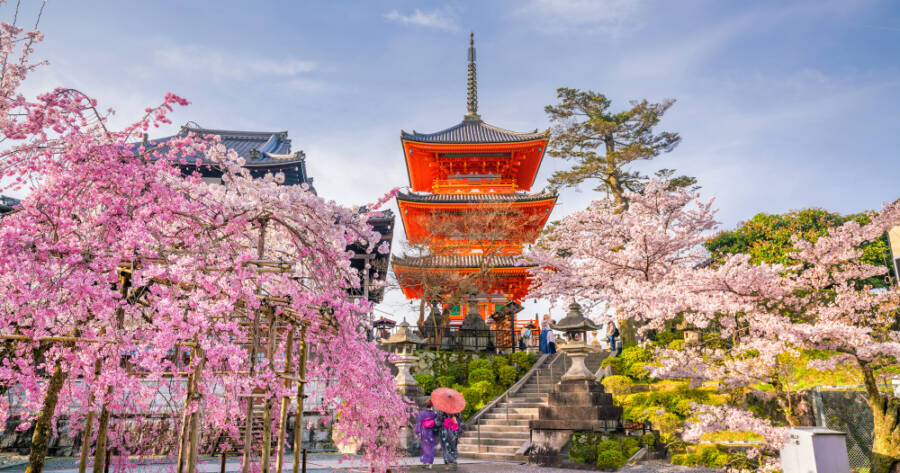Kyoto, Japan’s ancient capital, is a city where history and nature blend seamlessly. Known for its stunning temples, traditional tea houses, and beautifully preserved gardens, Kyoto offers a glimpse into Japan’s past while maintaining a peaceful atmosphere. Visitors can wander through centuries-old shrines, admire cherry blossoms in spring, and experience the quiet beauty of Zen gardens. Exploring Kyoto is more than just sightseeing—it’s a journey into Japan’s rich cultural heritage.
Kinkaku-ji: The Golden Pavilion
One of Kyoto’s most famous landmarks, Kinkaku-ji, or the Golden Pavilion, is a breathtaking Zen temple covered in gold leaf. The temple’s reflection in the surrounding pond creates a mesmerizing view that changes with the seasons. Originally built in the 14th century as a retirement villa for a shogun, it was later converted into a temple.
Visitors can stroll through the carefully designed gardens, which feature stone paths, small bridges, and peaceful ponds. The surrounding trees add to the beauty, whether they are covered in cherry blossoms in spring or fiery red leaves in autumn. Kinkaku-ji is a must-see for anyone visiting Kyoto, offering a perfect example of traditional Japanese aesthetics.
Fushimi Inari Taisha: A Path Through Thousands of Torii Gates
Fushimi Inari Taisha is one of Kyoto’s most iconic shrines, known for its striking pathway lined with thousands of vermillion torii gates. Dedicated to Inari, the Shinto god of rice and prosperity, this sacred site has drawn visitors for centuries. The shrine complex includes smaller shrines and fox statues, believed to be messengers of Inari.
Walking through the torii gates is a mesmerizing experience. The main path winds up Mount Inari, offering peaceful forest scenery and scenic overlooks of Kyoto. While the full hike takes around two to three hours, many visitors explore just a portion of the trail, enjoying the beauty and spiritual atmosphere. Visiting Fushimi Inari Taisha is a highlight of any Kyoto trip, combining history, nature, and cultural tradition.
Ryoan-ji: The Art of Zen Gardens
For those seeking tranquility, Ryoan-ji offers one of Japan’s most famous Zen rock gardens. This UNESCO World Heritage Site was originally an aristocratic estate before becoming a Zen temple in the 15th century. Its minimalist rock garden, composed of 15 carefully placed stones on a bed of white gravel, is designed to inspire meditation and contemplation.
No matter where visitors sit, at least one rock is always hidden from view, a mystery that adds to the garden’s allure. The surrounding temple grounds feature a serene pond and walking paths, perfect for a quiet moment of reflection. Ryoan-ji exemplifies the beauty of simplicity in Japanese culture and provides a peaceful retreat from Kyoto’s busy streets.
Gion District: Tradition and Elegance
Kyoto is not just about temples and gardens—it is also a city of living traditions. The Gion district, famous for its wooden machiya houses and traditional tea houses, is the heart of Kyoto’s geisha culture. Walking along its narrow streets feels like stepping into a different era, with paper lanterns glowing softly and kimono-clad women passing by.
In Gion, visitors can enjoy a traditional tea ceremony, dine in historic restaurants, or watch a performance of classical Japanese arts. Yasaka Shrine, located nearby, is especially vibrant in the evening, when its lanterns light up the night. A visit to Gion offers a glimpse into Kyoto’s refined culture, where history is preserved and celebrated.
Arashiyama: Bamboo Forest and Riverside Charm
Just outside Kyoto’s city center, Arashiyama is a stunning natural escape. The famous Bamboo Grove is a must-see, with towering green stalks swaying gently in the wind. Walking through the bamboo forest is a calming experience, with soft light filtering through the dense leaves, creating an almost dreamlike atmosphere.
Beyond the Bamboo Grove, the Togetsukyo Bridge spans the Katsura River, offering picturesque views of the surrounding mountains. Nearby, the Iwatayama Monkey Park allows visitors to observe Japanese macaques in their natural habitat. Arashiyama perfectly blends natural beauty with cultural landmarks, making it an essential stop for any Kyoto traveler.
Kyoto’s Timeless Beauty
Kyoto is a city where tradition and nature coexist in perfect harmony. Its temples, gardens, and historic districts provide a window into Japan’s past while maintaining their timeless beauty.
Whether exploring ancient shrines, meditating in a Zen garden, or walking through a bamboo forest, visitors can experience a unique blend of history, spirituality, and tranquility. A journey through Kyoto is more than just a trip—it is a deep and unforgettable cultural experience.

